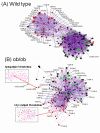Bioinformatics strategies for lipidomics analysis: characterization of obesity related hepatic steatosis
- PMID: 17408502
- PMCID: PMC1839890
- DOI: 10.1186/1752-0509-1-12
Bioinformatics strategies for lipidomics analysis: characterization of obesity related hepatic steatosis
Abstract
Background: Lipids are an important and highly diverse class of molecules having structural, energy storage and signaling roles. Modern analytical technologies afford screening of many lipid molecular species in parallel. One of the biggest challenges of lipidomics is elucidation of important pathobiological phenomena from the integration of the large amounts of new data becoming available.
Results: We present computational and informatics approaches to study lipid molecular profiles in the context of known metabolic pathways and established pathophysiological responses, utilizing information obtained from modern analytical technologies. In order to facilitate identification of lipids, we compute the scaffold of theoretically possible lipids based on known lipid building blocks such as polar head groups and fatty acids. Each compound entry is linked to the available information on lipid pathways and contains the information that can be utilized for its automated identification from high-throughput UPLC/MS-based lipidomics experiments. The utility of our approach is demonstrated by its application to the lipidomic characterization of the fatty liver of the genetically obese insulin resistant ob/ob mouse model. We investigate the changes of correlation structure of the lipidome using multivariate analysis, as well as reconstruct the pathways for specific molecular species of interest using available lipidomic and gene expression data.
Conclusion: The methodology presented herein facilitates identification and interpretation of high-throughput lipidomics data. In the context of the ob/ob mouse liver profiling, we have identified the parallel associations between the elevated triacylglycerol levels and the ceramides, as well as the putative activated ceramide-synthesis pathways.
Figures








References
-
- Vance DE, Vance JE. In: Biochemistry of lipids, lipoproteins and membranes. 4th. Bernardi G, editor. Amsterdam, The Netherlands, Elsevier B. V.; 2004.
-
- Fahy E, Subramaniam S, Brown HA, Glass CK, Merrill AH, Jr., Murphy RC, Raetz CRH, Russell DW, Seyama Y, Shaw W, Shimizu T, Spener F, van Meer G, VanNieuwenhze MS, White SH, Witztum JL, Dennis EA. A comprehensive classification system for lipids. J Lipid Res. 2005;46:839–862. doi: 10.1194/jlr.E400004-JLR200. - DOI - PubMed
Publication types
MeSH terms
Substances
Grants and funding
LinkOut - more resources
Full Text Sources
Other Literature Sources
Medical
Miscellaneous

